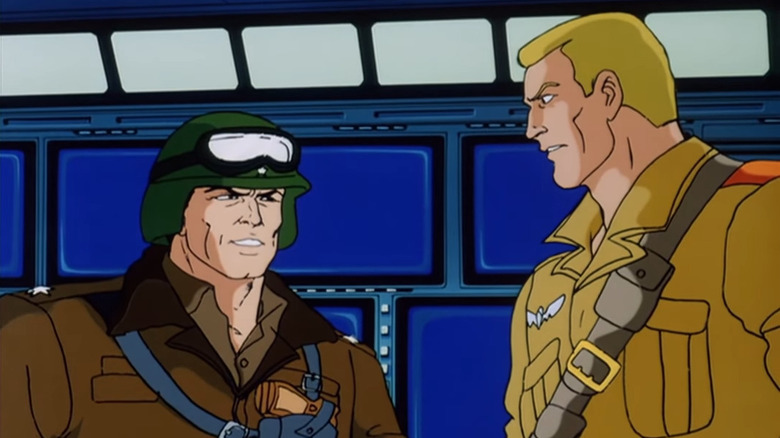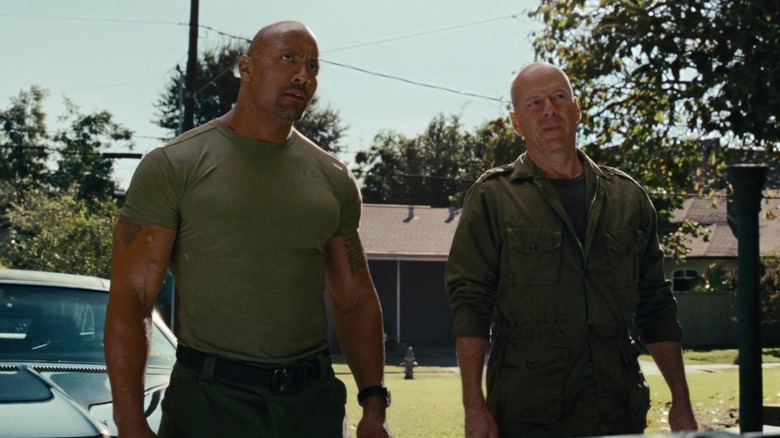GI Joe: The Real Life History Behind The Franchise's Iconic Name
If you are a certain age, you remember the late '80s "G.I. Joe" craze thanks to the animated television series and the iconic action figures. If you are too young to remember your parents avoiding the Walmart toy aisle to keep you from getting lost in the action figures, then you likely remember the films from 2009 and 2013 that featured Channing Tatum, Joseph Gordon-Levitt, Christopher Eccleston, Rachel Nichols, Dwayne Johnson, Bruce Willis, and even Dennis Quaid and Brendan Fraser. But do you know how the franchise creators landed on the name "G.I. Joe"?
According to legend (as recorded by Popular Mechanics), the original creation of the action figure needed a great name and a marketing campaign that would convince boys that they weren't playing with a doll that was the male version of Barbie but was something entirely different. What they landed on was inspired by the film "Story of G.I. Joe," a 1945 flick starring Robert Mitchum and Burgess Meredith following Pulitzer Prize-winning war correspondent Ernie Pyle (Meredith). Of course, an Academy Award-nominated film starring a western legend is a great way to capitalize on the name and engage customers.
The military-inspired action figures went on to inspire not only a much wider collection of available toys but comics, television, movies, and even novels by famed author R.L. Stine. Sixty years later, the popular franchise is primed to make a comeback now that they have appeared to set up a crossover with the massively popular "Transformers" franchise.
G.I. is an inside joke for soldiers
There is a lot of gear a soldier gets when they elect to serve their country. Uniforms, weapons, rucksacks, all "government issued." The idea behind this is uniformity and the ability to guarantee the same level of quality and appearance among the ranks. That eventually evolved, according to The History Channel, into a joke among the soldiers.
During World War II, the term G.I. was coined to sarcastically refer to the low-on-the-totem-pole soldiers who were fresh infantrymen out of training. While the men drafted into the war were given uniforms, gear, and weapons that were all the same, they were also trained and cultivated the same mentality and attitudes to go to war. That made them feel like they were created on an assembly line and, therefore, nameless, faceless, and easily replaceable. They became G.I.s or government-issued soldiers.
That sentimentality grew within the military all the way up to the halls of government when President Franklin Roosevelt signed into law the Serviceman's Readjustment Act in 1944. The act focused on providing aid for soldiers returning from war to help them reacclimate to a peaceful society, including tuition, training, and financial assistance. While it was not called this initially, it eventually became known as "The G.I. Bill." While the bill expired a little over a decade later, the '80s saw Mississippi Rep. Gillespie V. "Sonny" Montgomery reintroduce it after the Vietnam War, and it has lovingly been referred to as the "Montgomery G.I. Bill" ever since. G.I. became a staple in military jargon and began to spread to other areas of life, even to the toy market with Hasbro's G.I. Joe action figure line.
A deeper cut on the origins of G.I. Joe
Hasbro may have pulled their name for G.I. Joes from the Robert Mitchum movie, but the film itself possibly pulled that name from an even earlier source. According to his Obituary in the New York Times in 1970, cartoonist Dave Breger coined the phrase in his comic strip, "Yank," which started its run in 1942. This was three years before Mitchum landed his nomination for his sole Academy Award for his turn in the film.
According to TIME Magazine, Breger started posting his cartoons in the Saturday Evening Post, even catching the attention of the General of the European Theater, Dwight D. Eisenhower. When Breger worried that the general wouldn't be fond of him poking fun at the regimentation of the Army, he was assured that General Eisenhower just wanted to ensure a "laugh a day."
G.I. Joe is a long-running franchise that could be poised to make a comeback thanks to "Transformers: Rise of the Beasts" teasing a return in the form of a crossover. But the action figure is more than a toy; it is a reminder of how we, as a nation, dealt with the darkest time in generations. Even though we were introduced to evil in the world, we found a way to find passion and pride in our country in the form of action figures resembling real-life heroes and humor and a laugh a day in a name that endures today. Now you know how G.I. Joes got their name, and as they will tell you, "Knowing is half the battle."


